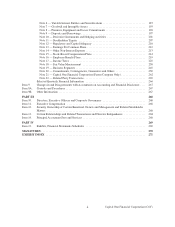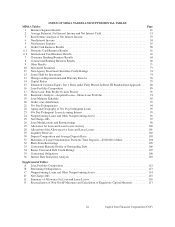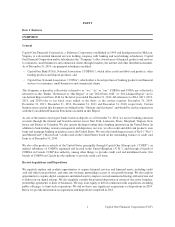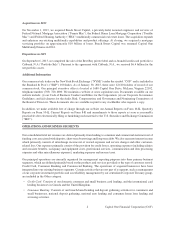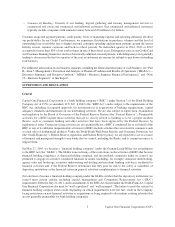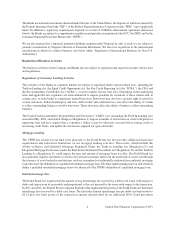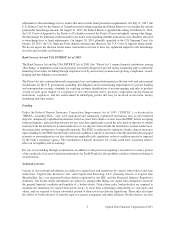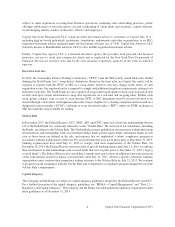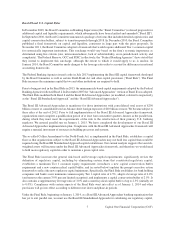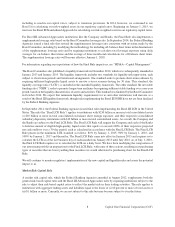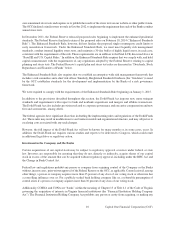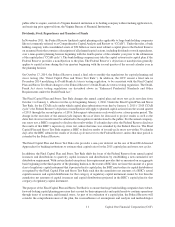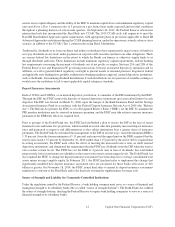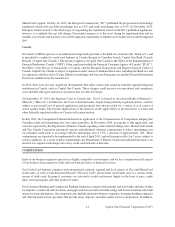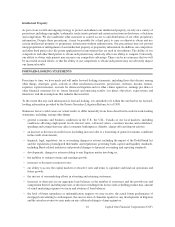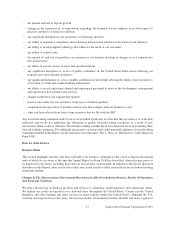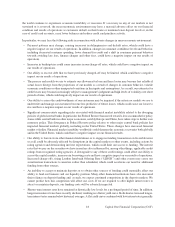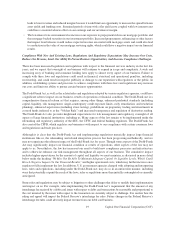Capital One 2014 Annual Report Download - page 31
Download and view the complete annual report
Please find page 31 of the 2014 Capital One annual report below. You can navigate through the pages in the report by either clicking on the pages listed below, or by using the keyword search tool below to find specific information within the annual report.FDICIA and Prompt Corrective Action
In general, the FDICIA subjects banks to significantly increased regulation and supervision. Among other things, the
FDICIA requires Federal Banking Agencies to take “prompt corrective action” for banks that do not meet minimum
capital requirements. The FDICIA establishes five capital ratio levels: well capitalized; adequately capitalized;
undercapitalized; significantly undercapitalized; and critically undercapitalized. Under applicable regulations for 2014,
an insured depository institution was considered to be well capitalized if it maintains a total risk-based capital ratio of
at least 10 percent, a Tier 1 risk-based capital ratio of at least 6 percent, a Tier 1 leverage capital ratio of at least 5
percent and is not subject to any supervisory agreement, order or directive to meet and maintain a specific capital level
for any capital measure. An insured depository institution was considered to be adequately capitalized if it maintains
a total risk-based capital ratio of at least 8 percent, a Tier 1 risk-based capital ratio of at least 4 percent, and a Tier 1
leverage capital ratio of at least 4 percent (3 percent for certain highly rated institutions), and does not otherwise meet
the definition of well capitalized. The three undercapitalized categories are based upon the amount by which a bank
falls below the ratios applicable to adequately-capitalized institutions. The capital categories are determined solely for
purposes of applying the FDICIA’s prompt corrective action provisions, and such capital categories may not constitute
an accurate representation of the Banks’ overall financial condition or prospects. As of December 31, 2014, each of
the Banks met the requirements for a well-capitalized institution.
As noted above, the Final Rule updates the prompt corrective action framework to reflect new, higher regulatory
capital minimums. This rule adjusts the definitions of well capitalized and adequately capitalized. For an insured
depository institution to be well capitalized, it must maintain a total risk-based capital ratio of 10 percent or more; a
Tier 1 capital ratio of 8 percent or more; a common equity Tier 1 capital ratio of 6.5 percent or more; and a
leverage ratio of 5 percent or more. An adequately-capitalized depository institution must maintain a total risk-based
capital ratio of 8 percent or more; a Tier 1 capital ratio of 6 percent or more; a common equity Tier 1 capital ratio of
4.5 percent or more; a leverage ratio of 4 percent or more; and, for Basel III Advanced Approaches institutions, a
supplementary leverage ratio, which incorporates a broader set of exposures, of 3 percent or more. The revised prompt
corrective action requirements became effective on January 1, 2015, other than the supplementary leverage ratio,
which becomes effective on January 1, 2018.
As an additional means to identify problems in the financial management of depository institutions, the FDICIA
requires regulators to establish certain non-capital safety and soundness standards. The standards relate generally
to operations and management, asset quality, interest rate exposure and executive compensation. In 2014, the OCC
issued regulatory guidelines that apply heightened standards for risk management to large institutions subject to its
supervision, including the Banks. The agencies are authorized to take action against institutions that fail to meet such
standards.
Enhanced Prudential Standards and Other Requirements under the Dodd-Frank Act
With the enactment of the Dodd-Frank Act, because we are a bank holding company with consolidated assets of
$50 billion or greater (a “covered company”), we are subject to certain enhanced prudential standards, including
requirements that may be recommended by the Financial Stability Oversight Council (the “Council”) and
implemented by the Federal Reserve and other regulators. As a result, we are becoming subject to more stringent
standards and requirements than those applicable for smaller institutions. The Council also may issue
recommendations to the Federal Reserve or other primary financial regulatory agency to apply new or heightened
standards to risky financial activities or practices.
In 2011, the Federal Reserve finalized rules requiring us to implement resolution planning for orderly resolution in the
event the Company faces material financial distress or failure. The FDIC issued similar rules regarding resolution planning
applicable to the Banks. In addition, in October 2012, the Federal Reserve issued a rule that implements the requirement
in the Dodd-Frank Act that the Federal Reserve conduct annual stress tests on the capacity of our capital to absorb losses
as a result of adverse economic conditions. The stress test rule also implements the requirement that we conduct our
9Capital One Financial Corporation (COF)


